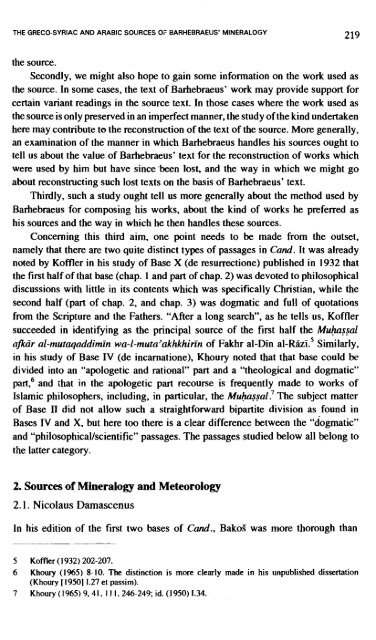doc.pdf
doc.pdf
doc.pdf
Create successful ePaper yourself
Turn your PDF publications into a flip-book with our unique Google optimized e-Paper software.
THE GRECO-SYRIAC AND ARABIC SOURCES OF BARHEBRAEUS' MINERALOGY 219<br />
the source.<br />
Secondly, we might also hope to gain some information on the work used as<br />
the source. In some cases, the text of Barhebraeus' work may provide support for<br />
certain variant readings in the source text. In those cases where the work used as<br />
the source is only preserved in an imperfect manner, the study of the kind undertaken<br />
here may contribute to the reconstruction of the text of the source. More generally,<br />
an examination of the manner in which Barhebraeus handles his sources ought to<br />
tell us about the value of Barhebraeus' text for the reconstruction of works which<br />
were used by him but have since 'been lost, and the way in which we might go<br />
about reconstructing such lost texts on the basis of Barhebraeus' text.<br />
Thirdly, such a study ought tell us more generally about the method used by<br />
Barhebraeus for composing his works, about the kind of works he preferred as<br />
his sources and the way in which he then handles these sources.<br />
Concerning this third aim, one point needs to be made from the outset,<br />
namely that there are two quite distinct types of passages in Cand. It was already<br />
noted by Koffler in his study of Base X (de resurrectione) published in 1932 that<br />
the first half of that base (chap. 1 and part of chap. 2) was devoted to philosophical<br />
discussions with little in its contents which was specifically Christian, while the<br />
second half (part of chap. 2, and chap. 3) was dogmatic and full of quotations<br />
from the Scripture and the Fathers. "After a long search", as he tells us, Koffler<br />
succeeded in identifying as the principal source of the first half the Mu?uzssal<br />
ajk& al-mutaqaddimin wa-1-muta"akhkhirin of Fakhr al-Din al-~iizi.' Similarly,<br />
in his study of Base IV (de incarnatione), Khoury noted that that base could be<br />
divided into an "apologetic and rational" part and a "theological and dogmatic"<br />
part,6 and that in the apologetic part recourse is frequently made to works of<br />
Islamic philosophers, including, in particular, the ~u&ssal.~ The subject matter<br />
of Base II did not allow such a straightforward bipartite division as found in<br />
Bases I'V and X, but here too there is a clear difference between the "dogmatic"<br />
and "philosophical/scientific" passages. The passages studied below all belong to<br />
the latter category.<br />
2. Sources of Mineralogy and Meteorology<br />
2.1. Nicolaus Damascenus<br />
In his edition of the first two bases of Cand., BakoS was more thorough than<br />
5 Koffler ( 1932) 202-207.<br />
6 Khoury (1965) 8-10. The distinction is more clearly made in his unpublished dissertation<br />
(Khoury [I9501 1.27 et passim).<br />
7 Khoury ( 1965) 9.41. l l I. 246-249; id. (1950) 1.34.
















